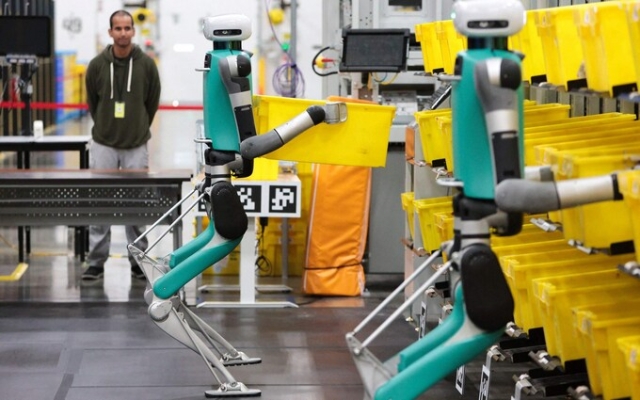 Digital robots will initially be used to collect empty bins for workers. Photo: Jason Redmond/AFP
Digital robots will initially be used to collect empty bins for workers. Photo: Jason Redmond/AFP
Amazon has begun testing humanoid robots in its warehouses, insisting the machines will help eliminate repetitive tasks rather than replace humans.
The US tech giant has deployed a mobile, bipedal robot called Digit, which can lift and move containers using its «arms». » at one of the company's warehouses near Seattle.
The machine is 5 feet 9 inches tall, weighs 65 kg and can support up to 35 kg.
Amazon's blog says, «Its size and shape are well suited for human-occupied buildings, and we believe there is great potential to scale a mobile device like Digit that can work collaboratively with employees.»
The robot will initially be used to collect empty baskets for workers, meaning people won't have to lift as many.
Digit was created by Agility Robotics, an Amazon startup that was backed by a $1bn (£820m) investment fund last year.
The launch comes amid concerns that artificial intelligence and robotic automation could quickly replace millions of jobs in both offices and factories.
Ty Brady, chief technology officer of Amazon Robotics, told reporters that people are “indispensable” in fulfillment centers. He said the launch of Digit «doesn't» mean Amazon will need fewer people, the Guardian reports.
Mr Brady said robots could help «eliminate all the menial, mundane and repetitive» tasks in Amazon's business.
But Professor Carl Frey, an artificial intelligence expert at Oxford University, said: «Warehouse automation is precisely here was factory automation in the 1980s… you saw companies essentially redesigning and changing the manufacturing environment to make it easier for robots to navigate.
“It will mean fewer jobs in the future, but that doesn't mean warehouses will be fully automated, you still have technicians.
“I do think there will be fewer people working in warehouses in the future of people. the future.”
The technology giant has already deployed hundreds of thousands of other robotic machines in its operations.
On Wednesday, it announced the deployment of a robotic system called Sequoia to the warehouse. in Houston. This system combines a robotic workstation with machines to collect and sort packages for delivery.
In a blog post, Amazon wrote: “With this system, associates will no longer have to regularly raise their arms above their heads or crouch down to pick up customer orders, supporting our efforts to reduce risk. injuries.”
In the US, the technology company has come under pressure from politicians to explain injury rates at some of its warehouses.
It has also developed a robotic arm called Sparrow that can identify and sort millions of different types of items.
Amazon reported that the rate of lost time incidents was 18% lower in facilities where robots were deployed, compared to warehouses where only human workers were employed.
Despite concerns about job losses due to robots, Karsten Heer of the World Federation of Robotics said that despite large-scale factory automation, many companies are still struggling to hire enough workers.
He said: “Is it true that companies have enough workers or are we facing a labor shortage on a massive scale these days? Labor statistics show that we have a shortage, and this is a real problem.»
He added that robots are largely just «dumb machines» useful for the simplest tasks but unable to adapt or respond to warehouse tasks.
Ford has been testing humanoid robots made by Agility Robotics since 2020 of the year. are testing them as a means of delivering packages from self-driving vans.
Other technology companies have introduced mass delivery automation. Ocado has developed warehouses that use robots to pick and sort bins of products for delivery.
Car makers, meanwhile, have long used robotic machines to automate production lines.
Amazon's humanoid robots are more unusual . Many companies have been struggling for years to develop machines that could walk or move like humans, with mixed results.
Simon Jones of warehouse automation company Exotec says: “It's clear there's a lot of promise in this technology, and they will find application in a variety of industries, but I’m not entirely sure that these robots will replace non-humanoid designs that are already well adapted to warehouse work.”























































Свежие комментарии